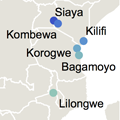Abstract
Background: The RTS,S/AS01 vaccine targets the circumsporozoite protein of Plasmodium falciparum and has partial protective efficacy against clinical and severe malaria dis- ease in infants and children. We investigated whether the vaccine efficacy was specific to certain parasite genotypes at the circumsporozoite protein locus.
Methods: We used polymerase chain reaction–based next-generation sequencing of DNA extracted from samples from 4985 participants to survey circumsporozoite protein polymorphisms. We evaluated the effect that polymorphic positions and haplotypic regions within the circumsporozoite protein had on vaccine efficacy against first episodes of clinical malaria within 1 year after vaccination.
Results: In the per-protocol group of 4577 RTS,S/AS01-vaccinated participants and 2335 control-vaccinated participants who were 5 to 17 months of age, the 1-year cumulative vaccine efficacy was 50.3% (95% confidence interval [CI], 34.6 to 62.3) against clinical malaria in which parasites matched the vaccine in the entire circumsporozoite protein C-terminal (139 infections), as compared with 33.4% (95% CI, 29.3 to 37.2) against mismatched malaria (1951 infections) (P=0.04 for differential vaccine efficacy). The vaccine efficacy based on the hazard ratio was 62.7% (95% CI, 51.6 to 71.3) against matched infections versus 54.2% (95% CI, 49.9 to 58.1) against mismatched infections (P=0.06). In the group of infants 6 to 12 weeks of age, there was no evidence of differential allele-specific vaccine efficacy.
Conclusions: These results suggest that among children 5 to 17 months of age, the RTS,S vaccine has greater activity against malaria parasites with the matched circumsporo- zoite protein allele than against mismatched malaria. The overall vaccine efficacy in this age category will depend on the proportion of matched alleles in the local parasite population; in this trial, less than 10% of parasites had matched alleles.
